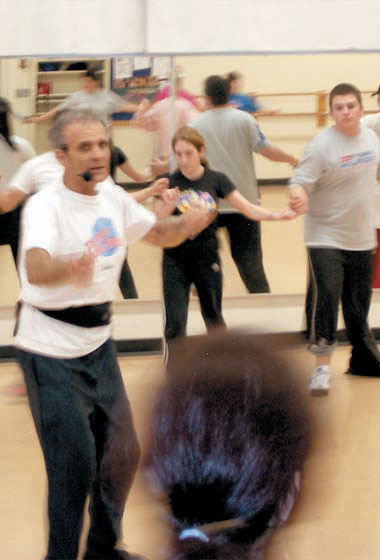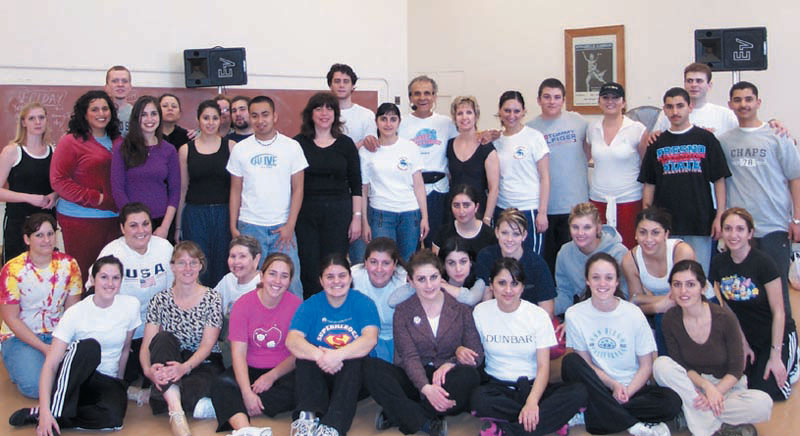Sarah Soghomonian
Staff Writer

The sound of Armenian music and stomping feet rang from Fresno State’s South Gym Feb. 5 and 6 when the 5th Annual Armenian Dance Seminar took place.
Tom Bozigian taught the seminar, which was attended by 40 people: 30 students from Fresno State and 10 people from the community. Bozigian was born in Los Angeles, but was raised in Fresno. He graduated from Fresno State with degrees in Industrial Arts Education and Russian Studies. Bozigian resides in La Mirada, in Southern California, but travels around the world teaching Armenian dance.
Bozigian began teaching Armenian dancing 41 years ago. He said he was drawn to Armenian dancing at a young age while attending Armenian events such as picnics.
Teaching Armenian dancing has allowed Bozigian to travel the world. In the coming months he will be traveling to Washington DC, Japan, Holland, Denmark and Germany. Bozigian conducts classes in Los Angeles every Wednesday and Thursday. The majority of his classes are conducted in Armenian.
An orchestra accompanies Bozigian during many of his classes taught in Los Angeles. The orchestra allows for students to dance to live Armenian music.
Bozigian loves teaching Armenian dance at Fresno State and looks forward to coming each spring. In this, his fifth time teaching on campus, he focused on dances that originated in Van. He taught 10 dances to the class during the fun filled weekend.

Suzie Pogosyan, 18, a freshman majoring in Fashion Design said she took the class “to have fun.” She hoped to learn how to dance in a traditional manner and improve the dancing skills she has learned at parties and weddings.
Bernadette Moordigian a senior majoring in Psychology said she took the course to get closer to her roots. Moordigian did not have any previous Armenian dance experience, but hoped to learn about the origin of dance and gain knowledge about her culture through the course.
Lore Dubusch was one of the non-Fresno State students who participated in the dance seminar. Dobusch took the course because she had both personal and professional interest in the subject. As a counselor at Reedley College she believes cultural development is an important form of study.
Dubusch said, “I loves all types of dance” and hoped to learn Armenian dancing well enough to feel comfortable dancing at festivals.
Dance Source Material
Armenian Dance Seminar Fresno State
Govand (2/4) This is the name of a family of dances of which Kocharee/Halay are members. Govand means encircled, fortified, close-knit which dancers demonstrate in this dance. Immigrants brought the dance to the U.S. from Vaspurakan/Van Province.
Hashtayee (6/8) This dance was brought by Persian Armenians to the USA during the 60’s & 70’s—it means “8 Times.” It is very popular among the Persian Armenian communities in Armenia.
Hayr oo Mamoogner/Lorge (2/4) Bozigian learned the first dance from Arsen Anoushian (Sepastatsi) an original member of the N.Y. Folkdance Society. The bowing in the dance was a gesture of respect shown to the fathers and grandmothers during a Vanetsi wedding. Bozigian learned this variation of Lorge from Yenovk Kazarian in Detroit. Both sources have passed away.
Jurjena (10/4) This dance is named after the rhythm. It hails from Kharpert region. As a child, Bozigian had the opportunity to dance with many elderly Kharpert Armenian immigrants in Fresno. His maternal side immigrated from the region. Many interesting dances have evolved through the centuries with this unique rhythm.
Loorke (2/4) Bozigian had the opportunity to learn many variations of this “Vanetsi” dance during his youth. The meaning is shake in Kurdo Persian. Some variations demonstrate “Gagh” (limping) or “Pati Kael” (duck walk) in their movements.
Oee Naze (2/4) During Bozigian’s dance studies in Armenia (1972-75), he spent time with the famous singer Hovaness Badalian who taught him this Kurdish Armenian dance named after a girl “Naze.” Badalian grew up with Kurds in Tehran, Iran and spoke their language.
Sepo (2/4 – 6/8) This dance is among a list of dances from the region of Sepastia still performed in the USA, Armenia and in various parts of the diaspora. Some others are Beejo, Jahn Perde, Hekeree, Chekeen Halay. Bozigian danced Sepo as a youth during the mid-1950’s at Fresno summer picnics.
Sjeikhani-Ishkani (2/4) These are a cycle of dances tied to the Assyrian people. Sheikh means Prince in Assyrian—Ishkani is the same in Armenian.
Sulemani/Kerdze (10/8 – 2/4) These 2 dances were learned by Bozigian from Yenovk Kazarian of Detroit during the mid-1970’s. Yenovk came from Van where his father, Khachig, was a noted specialist of regional dances of Vaspurakan. Another famous family member includes grandson clarinetist, Khachig Kazarian.
 Hye Sharzhoom Armenian Action
Hye Sharzhoom Armenian Action